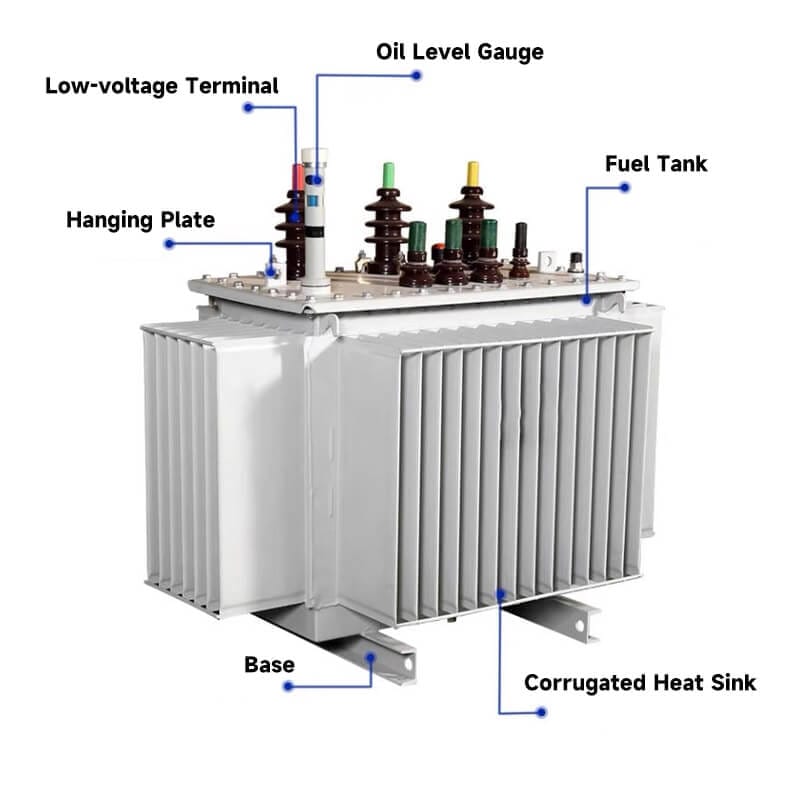What is inside a power transformer? As a core device for energy conversion and transmission in power systems, the performance, efficiency, and service life of a transformer directly depend on the selection of main materials and structural design.Now, everyone is right oil immersed transformer Are more concerned, hoping to get more benefits from it. https://www.jslhtf.com/
From energy conversion in the magnetic circuit to current conduction in the circuit, from safety protection by insulation to stable support by structures, the characteristics of each material profoundly affect the operational performance of the transformer.
This article will comprehensively dissect the core materials and structural details of the transformer main body, helping industry professionals and power practitioners gain an in-depth understanding of its working principles and selection logic.
what-is-inside-a-power-transformer-3
Magnetic Circuit Materials: The ^Heart ̄ of Transformer Energy Conversion
The magnetic circuit is the core link for a transformer to achieve electromagnetic induction. The magnetic properties of its materials directly determine no-load loss, volume, and energy efficiency. Currently, mainstream magnetic circuit materials include silicon steel sheets and amorphous alloy cores, each with its own focus in performance, craftsmanship, and application scenarios.
1. Silicon Steel Sheets: The ^Performance Leader ̄ Among Traditional Magnetic Circuit Materials
Silicon steel sheets (also known as electrical steel) are the mainstream material for transformer cores. Their core role is to achieve efficient conduction of magnetic flux through high magnetic permeability while reducing iron loss (hysteresis loss and eddy current loss). The performance requirements for silicon steel sheets focus on three core indicators: low iron loss, high magnetic induction, and good processability.
Low iron loss: Iron loss is the main source of transformer no-load loss. The lower the iron loss, the more energy-efficient the transformer operation. Countries classify grades based on iron loss values. For example, China¨s 30Q120 silicon steel sheet has an iron loss value (P17/50) + 1.20W/kg, suitable for high-efficiency transformers.
High magnetic induction: High magnetic induction intensity (such as B800A) under a strong magnetic field can reduce the core volume and save materials. For instance, the B800A of ordinary cold-rolled grain-oriented silicon steel sheets (CGO) is 1.78~1.85T, while that of high-magnetic-permeability silicon steel sheets (Hi-B steel) can reach above 1.85T, reducing core weight by approximately 10%-15%.
Good processability: Silicon steel sheets with smooth surfaces, uniform thickness, and good punchability can improve the core filling factor. Typically, high-quality silicon steel sheets have a filling factor of over 0.97, reducing losses caused by magnetic circuit gaps.
what-is-inside-a-power-transformer-7
Classification and Application Scenarios of Silicon Steel Sheets
According to performance and processing technology, silicon steel sheets can be divided into three categories, suitable for transformer energy efficiency requirements:
Ordinary cold-rolled grain-oriented silicon steel sheets (CGO): Suitable for transformers with medium and low voltage and moderate energy efficiency requirements (such as 35kV and below distribution transformers). The deviation of grain orientation from the rolling direction is about 7<, B800A is approximately 1.80T, with moderate iron loss and relatively low cost.
High-magnetic-permeability silicon steel sheets (Hi-B steel): The Gaussian orientation texture degree is significantly improved through a secondary recrystallization process, with a grain orientation deviation of only 3< from the rolling direction. B800A can reach above 1.88T, and iron loss is 20%-30% lower than that of CGO. It is suitable for high-voltage transformers (110kV and above) or high-efficiency distribution transformers.
Laser-scribed silicon steel sheets: Based on Hi-B steel, laser beam irradiation technology is used to generate micro-strain on the surface, further refining the magnetic axis, and reducing iron loss by 5%-10% compared with Hi-B steel. However, annealing treatment should be avoided (high temperature will eliminate the laser treatment effect), and it is mostly used in scenarios with extremely high requirements for no-load loss (such as new energy power station supporting transformers).
2. Amorphous Alloy Cores: The ^New Force ̄ in Energy-Saving Transformers
Amorphous alloy is a new type of soft magnetic material developed in the 1970s. It forms a thin strip (0.02-0.03mm thick) through ultra-rapid cooling technology (cooling rate up to 10?≧/s) with a non-crystalline structure. Its hysteresis loss is only 20%-30% of that of silicon steel sheets, making it the most energy-efficient magnetic circuit material currently.
Core Advantages
Extreme energy saving: Transformers using amorphous alloy cores have no-load loss reduced by 70%-80% and no-load current reduced by more than 50% compared with silicon steel sheet transformers. Taking a 1000kVA distribution transformer as an example, annual electricity savings can reach thousands of degrees, especially suitable for grid distribution transformers that operate for a long time.
Simplified craftsmanship:As a non-oriented material, it can adopt a direct seam structure, making the core manufacturing process simpler; however, due to material characteristics, it can only be made into a wound core (cannot be laminated) and needs to be purchased as a whole.
Application Limitations and Breakthrough Directions
Despite significant energy-saving advantages, amorphous alloy cores still have some problems to be solved:
Low saturation magnetic induction: The saturation magnetic induction is about 1.56T (1.9T for silicon steel sheets), and the design magnetic induction needs to be reduced by 20% (oil-immersed transformers + 1.35T, dry-type transformers + 1.2T), resulting in a slightly larger core volume.
Stress sensitivity: The no-load performance of the strip is prone to deterioration after being stressed, so a suspended structure (only subject to its own gravity) should be adopted, and tapping is strictly prohibited during assembly.
Difficulty in noise control: Magnetostriction is 10% larger than that of silicon steel sheets, so it is necessary to control noise by reducing the design magnetic induction (such as design magnetic induction + 1.2T in sensitive areas) to meet the sound level requirements of the power grid for sensitive areas.
Domestic progress: At present, domestic companies such as Advanced Technology & Materials Co., Ltd. and Qingdao Yunlu have achieved mass production of 213mm, 170mm, and other wide strips, with performance gradually approaching imported Hitachi Metals products, and cost advantages are becoming increasingly prominent.
Circuit Materials: The ^Vessels ̄ for Current Conduction